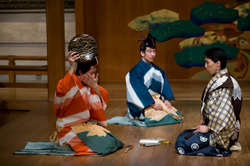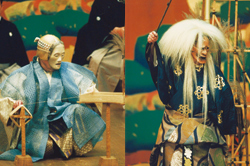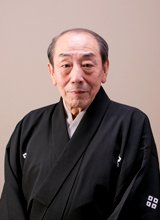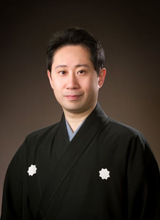An Evening of Noh and Kyogen 2014
The Japan Foundation Kyoto Office will organize "An Evening of Noh and Kyogen" to provide foreigners such as students and researchers from around the world with an opportunity to experience Japanese traditional culture.
| Date | Friday, November 21, 2014 6:30 p.m. (Doors will open at 6:00 p.m.) |
|---|---|
| Venue | Kyoto Kanze Kaikan (44 Okazaki, Enshoji-cho,Sakyo-ku, Kyoto ) |
| Programme |
A Kyogen play,FUTARI BAKAMA(Two People in One Hakama) A Noh play, ADACHIGAHARA |
| Organizers | |
| Collaboration | Katayama Noh and Kyomai Preservation Foundation, Kyoto Kanzekai |
| Endorsement | Kyoto Prefecture, Kyoto City, Kyoto City Tourist Association, The Kyoto Shimbun Co., Ltd. |
| Admission Fees (All seats are Unreserved) |
¥3,500 ( ¥2,000 for students ) |
| Tickets |
Kyoto Kanze Kaikan The Japan Foundation Kyoto Office *Tickets will be available from Friday, October 3 |
Programme Synopsis
Kyogen: FUTARI BAKAMA(Two People in One Hakama )

Synopsis:
A Groom prepares to make his ceremonial first visit to his Father-in-law. He is very shy and insists that his Father go with him. His Father goes with him as far as the front gate of the Father-in-law’s house and plans to wait there for him. Tarō Kaja sees the Father, informs the Father-in-law, and the Father-in-law asks to see the Father too. They have only brought one hakama so the Groom takes it off and the Father puts it on and appears before the Father-in-law. This exchange is performed several times till the Father-in-law finally insists that they appear together. They tear the hakama in two and appear with only a half a hakama in front of each of them. They perform the ceremony, drink and begin to dance. In the dances, the Father and the Groom never make any turns except when the Father-in-law and Tarō Kaja aren’t looking. The Father-in-law suggests that they all three dance together and while they are dancing, Tarō Kaja discovers that the Father’s and the Groom’s hakama are only half a hakama each. They are embarrassed, throw the hakama over their faces and run off. The Father-in-law tries to call them back saying that they shoudn’t worry about a little thing like that.
<From A GUIDE TO KYOGEN by Don Kenny, Hinoki Shoten, 1990>
Noh: ADACHIGAHARA

Synopsis:
Two travelling priests are given shelter for the night in the house of a poor woman at Kurozuka in Adachigahara. When she leaves them to collect firewood, she warns them not to look into her room, but the priests’ servant is unable restrain his curiosity. The horrifying things he sees there convince the priests that they are in the house of a devil. The woman then appears as an angry demon, but is finally overcome by the power of the priests.
<From A GUIDE TO NŌ 5th ed. by P. G. O’neill, Hinoki Shoten,1954>
Profile
Profile of SHIGEYAMA Sengoro XIII - Okura School Kyogen actor-

Born in 1945. Eldest son of Shigeyama Sensaku IV (Living National Treasure and member of Japan Art Academy) of the Okura school of Kyogen. Sengoro studied under his grandfather Sensaku III and father Sensaku IV. He made his stage debut as a shite actor in 1949 in the play “Iroha.”
Sengoro XIII performed overseas for the first time in 1973 in Europe, followed by a number of tours in Europe and the United States. He organized the Hanagata Kyogen Kai association of young Kyogen actors in 1976. He is recipient of the Kyoto Municipal New Artist Award (1986), the Kyoto Prefectural Culture Award’s Distinguished Service Prize (2004), and the National Arts Festival Grand Prize (2008). He is a holder of Important Intangible Cultural Properties (collective recognition).
In 1990 he was sent by the Japan Foundation to perform in a series of programs in Southeast Asia.
In 1994 he succeeded to the name Shigeyama Sengoro.
Profile of KATAYAMA Kurouemon-Kanze School Noh actor-

A shite (primary actor) of the Kanze School of Noh, Kurouemon Katayama was born in 1964 as the first son of KATAYAMA Yusetsu (Kurouemon Katayama IX ・living national treasure). His grandmother was the late Yachiyo Inoue IV (also a living national treasure), former head of the Inoue School of the traditional Kyoto Kyomai dance, and his older sister is Yachiyo Inoue V, head of the Inoue School. From childhood, Katayama studied Noh under his father and then Tetsunojo Kanze VIII. Together with his father, he organizes the Katayama Regular Noh performances. He performs frequently in theaters throughout the country, and often joins overseas tours to Europe, the United States, and other countries as well.
Katayama is involved in a variety of activities which are designed to share the joy of Noh with younger generations, including visiting Noh classes at schools, production of Noh picture books, stage production making full use of visual images, and the creation of virtual Noh plays using computer graphics technology.
Kurouemon Katayama is a recipient of the Kyoto Prefectural Cultural Encouragement Award (1997), the Kyoto Municipal New Artist Award (2003), the New Artist Award of the National Arts Festival of the Agency for Cultural Affairs (2003), the Japan Traditional Cultures Foundation Award (2007), the Kyoto Prefectural Culture Award’s Distinguished Service Prize (2013), and He succeeded the stage name Kurouemon KATAYAMA, the 10th (2011). He is one of a number of individuals who have been collectively designated as holders of Intangible Cultural properties, and he also serves as director of the Kyoto Kanze Kai association and executive director of the Katayama Noh and Kyomai Preservation Foundation.
[Contact Us]
The Japan Foundation Kyoto Office
(3rd Floor, Kyoto International Community House 2-1 Torii-cho, Awataguchi, Sakyo-ku, Kyoto)
Tel: 075-762-1136
- About Us Top
- About the Japan Foundation
- Donations
- News & Topics
- News & Topics Top
- Main Activities
- Main Activities Top
- Fiscal Year 2025-2026
- Fiscal Year 2024-2025
- Fiscal Year 2023-2024
- Fiscal Year 2022-2023
- Fiscal Year 2021-2022
- Fiscal Year 2020-2021
- Fiscal Year 2019-2020
- Fiscal Year 2018-2019
- Fiscal Year 2017-2018
- Fiscal Year 2016-2017
- Fiscal Year 2015-2016
- Fiscal Year 2014-2015
- Fiscal Year 2013-2014
- Events / Projects
- Press Release
- Press Release Top
- Fiscal Year 2025-2026
- Fiscal Year 2024-2025
- Fiscal Year 2023-2024
- Fiscal Year 2022-2023
- Fiscal Year 2021-2022
- Fiscal Year 2020-2021
- Fiscal Year 2019-2020
- Fiscal Year 2018-2019
- Fiscal Year 2017-2018
- Fiscal Year 2016-2017
- Fiscal Year 2015-2016
- Fiscal Year 2014-2015
- Fiscal Year 2013-2014
- Links
